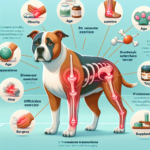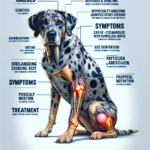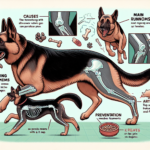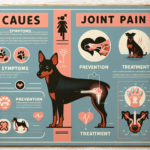Berger Picard Joint Pain: Causes, Symptoms, Prevention, and Treatment
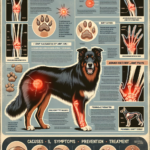
Introduction
The Berger Picard, also known as the Picardy Shepherd, is a rare and ancient breed of herding dog originating from the Picardy region of France. Known for their distinctive rough coat, expressive eyes, and erect ears, Berger Picards are intelligent, loyal, and versatile working dogs. They have a rich history dating back to the Middle Ages, and despite their near extinction after the World Wars, they have made a remarkable comeback thanks to dedicated breeders and enthusiasts.
Like many breeds, Berger Picards are prone to certain health issues, with joint pain being a significant concern. Joint health is crucial for maintaining the breed’s active and agile nature, as joint problems can severely impact their quality of life and ability to perform tasks.
Breed-Specific Joint Pain Risks
Genetic Predisposition
Berger Picards, like many other breeds, have a genetic predisposition to joint-related issues. Hip dysplasia, a condition where the hip joint doesn’t fit properly into the hip socket, is particularly common. This can lead to arthritis and significant pain over time. Elbow dysplasia, another hereditary condition, affects the elbow joints and can cause lameness and discomfort.
Age-Related Risks
As Berger Picards age, the risk of developing joint pain increases. While they are generally healthy dogs, the wear and tear on their joints over the years can lead to conditions like osteoarthritis. Owners should be vigilant as their dogs approach middle age, typically around 5-7 years, and continue monitoring as they become seniors.
Activity Level and Joint Stress
Berger Picards are active and energetic dogs, often used in herding, agility, and other high-energy activities. While their activity level is beneficial for their overall health, it can also contribute to joint stress. Repetitive motions and high-impact activities can exacerbate existing joint issues or lead to new ones, making it essential to balance exercise with joint care.
Common Symptoms of Joint Pain in Berger Picards
General Symptoms
- Limping: One of the most noticeable signs of joint pain is limping or favoring one leg over another.
- Stiffness: Dogs may show stiffness, especially after resting or sleeping, which can indicate joint discomfort.
- Reluctance to Move: A dog in pain may be hesitant to jump, run, or even walk.
- Swelling: Swelling around the joints can be a visible sign of inflammation and pain.
- Behavioral Changes: Irritability, lethargy, or changes in appetite can also be indicators of joint pain.
Breed-Specific Symptoms
In Berger Picards, joint pain may manifest as a reluctance to perform tasks they previously enjoyed, such as herding or agility exercises. They may also show a decrease in their typically high energy levels and become more sedentary.
When to Consult a Vet
If you notice any of the above symptoms, it’s crucial to consult a veterinarian. Early intervention can prevent further deterioration and improve your dog’s quality of life. Regular check-ups are also essential for early detection and management of joint issues.
Preventive Measures for Joint Health
Exercise Recommendations
Maintaining an appropriate exercise routine is vital for Berger Picards. Low-impact activities such as swimming and controlled walking can help keep their joints healthy without causing excessive stress. Avoid high-impact activities like jumping or running on hard surfaces, especially for older dogs.
Dietary Suggestions
A balanced diet rich in essential nutrients can support joint health. Foods containing glucosamine, chondroitin, and omega-3 fatty acids are particularly beneficial. These nutrients help maintain cartilage health and reduce inflammation. Consider high-quality commercial dog foods formulated for joint health or consult your vet for specific dietary recommendations.
Weight Management
Maintaining a healthy weight is crucial for reducing joint stress. Overweight dogs are more prone to joint issues due to the extra load on their joints. Regular exercise and a balanced diet can help keep your Berger Picard at an optimal weight.
Early Screening and Monitoring
Early screening for joint issues can make a significant difference in managing and preventing severe problems. Regular veterinary check-ups, including X-rays and physical examinations, can help detect early signs of joint issues. Genetic testing can also identify predispositions to conditions like hip and elbow dysplasia.
Treatment Options for Joint Pain
Non-Surgical Treatments
Non-surgical treatments are often the first line of defense against joint pain. These can include:
- Medications: Anti-inflammatory drugs and pain relievers can help manage pain and reduce inflammation.
- Physical Therapy: Exercises and therapies designed to strengthen muscles and improve joint function can be highly effective.
- Lifestyle Adjustments: Modifying your dog’s activity level and providing a comfortable living environment can alleviate joint stress.
Surgical Options
In severe cases, surgical intervention may be necessary. Common surgeries for joint issues include:
- Hip Replacement: Replacing the damaged hip joint with an artificial one can significantly improve mobility and reduce pain.
- Arthroscopy: A minimally invasive procedure to clean out the joint and remove damaged tissue.
- Osteotomy: Cutting and realigning bones to improve joint function and reduce pain.
Alternative Therapies
Alternative therapies can complement traditional treatments and provide additional relief. These include:
- Acupuncture: This ancient practice can help reduce pain and improve joint function.
- Hydrotherapy: Water-based exercises can strengthen muscles without putting stress on the joints.
- Massage: Regular massages can improve circulation and reduce muscle tension around the joints.
Lifestyle and Management Tips
Daily Care Routine
A consistent daily care routine can help manage joint pain in Berger Picards. This can include:
- Regular, low-impact exercise like walking or swimming.
- A balanced diet with joint-supporting nutrients.
- Administering any prescribed medications or supplements.
- Regular vet check-ups to monitor joint health.
Modifying the Home Environment
Making your home more comfortable for a dog with joint pain can significantly improve their quality of life. Consider:
- Installing ramps to help them navigate stairs or get onto furniture.
- Providing orthopedic beds to support their joints while resting.
- Ensuring their living area is free of slippery surfaces to prevent falls.
Long-Term Management
Long-term management of joint pain involves a combination of regular exercise, a balanced diet, and ongoing veterinary care. Keeping your Berger Picard active and engaged with low-impact activities can help maintain their physical and mental well-being.
FAQs About Berger Picards and Joint Pain
What are the early signs of joint pain in Berger Picards?
Early signs include limping, stiffness, reluctance to move, and behavioral changes such as irritability or lethargy.
Can joint pain in Berger Picards be prevented?
While genetic predispositions can’t be entirely prevented, maintaining a healthy weight, providing a balanced diet, and regular exercise can significantly reduce the risk of joint pain.
Are there specific foods that can help with joint health?
Yes, foods rich in glucosamine, chondroitin, and omega-3 fatty acids can support joint health. Consult your vet for specific dietary recommendations.
When should I consult a vet about my dog’s joint pain?
If you notice any signs of joint pain, such as limping or reluctance to move, it’s essential to consult a vet for early diagnosis and treatment.
What are the best exercises for a Berger Picard with joint pain?
Low-impact exercises like swimming and controlled walking are ideal for maintaining joint health without causing excessive stress.
Conclusion
Joint pain is a significant concern for Berger Picards, but with proper care and early intervention, it can be managed effectively. Regular exercise, a balanced diet, and ongoing veterinary care are crucial for maintaining joint health. By taking preventive measures and consulting your veterinarian regularly, you can ensure your Berger Picard remains active, healthy, and happy throughout their life.

